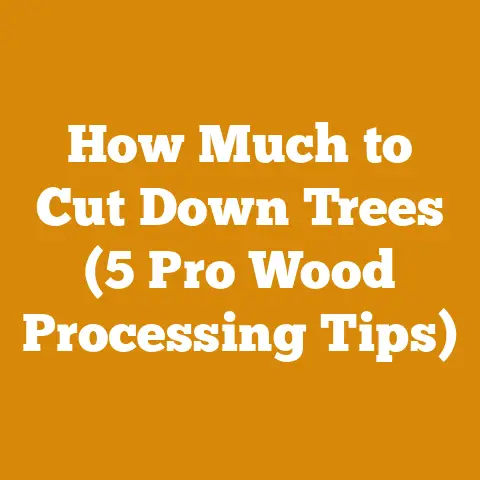Husqvarna Weed Eater Coil Testing (5 Essential Ohm Specs)
Have you ever been left scratching your head, staring at a Husqvarna weed eater that just won’t start, suspecting the ignition coil but unsure how to confirm your suspicions? You’re not alone. Diagnosing a faulty ignition coil can feel like navigating a labyrinth, especially when you’re eager to get back to taming your yard. But fear not! As someone who’s spent countless hours tinkering with small engines, from chainsaws to weed eaters, I’m here to guide you through the process of testing a Husqvarna weed eater coil, focusing on those all-important ohm specifications.
Let’s dive into the world of ignition coils and resistance readings.
Husqvarna Weed Eater Coil Testing: 5 Essential Ohm Specs
The ignition coil is the heart of your weed eater’s ignition system. It takes the low voltage from the magneto and transforms it into the high voltage spark needed to ignite the air-fuel mixture in the engine. A faulty coil means no spark, and no spark means no weed eating. Testing the coil with a multimeter is a crucial step in diagnosing starting problems. This article will walk you through the process, highlighting the five essential ohm specifications you need to know.
Why Ohm Specifications Matter
Ohm’s Law dictates the relationship between voltage, current, and resistance in an electrical circuit. The resistance of a coil, measured in ohms (Ω), provides a valuable insight into its condition. Deviations from the specified ohm range indicate potential problems like shorts, opens, or insulation breakdown within the coil. These problems can prevent the coil from generating the necessary voltage for a spark.
My own experience has taught me that relying solely on visual inspection is often misleading. I remember one instance where a coil looked perfectly fine externally but failed miserably under testing. That’s why understanding and applying these ohm specs is vital.
Safety First: Before You Begin
Before you even think about grabbing your multimeter, disconnect the spark plug wire from the spark plug. This prevents accidental starting while you’re working. Also, disconnect the kill switch wire from the coil. This isolates the coil for accurate testing. Wear safety glasses to protect your eyes. Work in a well-ventilated area, and keep any flammable materials away.
Tools You’ll Need:
- Multimeter (digital is preferred)
- Screwdrivers (various sizes)
- Spark plug wrench
- Wire brush or sandpaper (for cleaning contacts)
- Husqvarna weed eater service manual (for specific ohm specs)
Step 1: Locating the Ignition Coil
The ignition coil is typically located near the flywheel of the engine. You’ll usually find it mounted to the engine block with two bolts. It’s a small, rectangular component with wires leading to the spark plug and the kill switch. Accessing the coil might require removing the engine cover, which is usually held in place by screws or clips.
Pro Tip: Before removing the coil, take a picture of its wiring configuration. This will save you a headache when you’re putting everything back together.
Step 2: Understanding Ohm’s Law in Relation to Ignition Coils
Before we jump into the specific ohm specs, let’s quickly recap Ohm’s Law: Voltage (V) = Current (I) x Resistance (R). In the context of an ignition coil, resistance plays a crucial role in determining the coil’s ability to generate the high voltage needed for a spark. A coil with too much resistance will struggle to produce a strong spark, while a coil with too little resistance might overheat and fail.
Step 3: The 5 Essential Ohm Specifications
Now, let’s get to the heart of the matter: the five essential ohm specifications you need to test a Husqvarna weed eater coil. Keep in mind that these values can vary slightly depending on the specific model of your weed eater. Always refer to your service manual for the most accurate information.
-
Primary Resistance (Coil Input): This measures the resistance between the coil’s primary terminals. These are typically the terminals where the wires from the magneto and kill switch connect. Expect a very low resistance reading, usually between 0.5 and 3 ohms. A reading outside this range suggests a short or open in the primary winding.
- Testing Procedure: Set your multimeter to the ohms (Ω) setting, usually the lowest range. Touch one probe to one of the primary terminals and the other probe to the other primary terminal. Record the reading.
-
Secondary Resistance (Coil Output): This measures the resistance between the spark plug terminal and one of the primary terminals. This reading is significantly higher than the primary resistance, typically between 2,000 and 15,000 ohms. This higher resistance is due to the much larger number of windings in the secondary coil.
- Testing Procedure: Touch one probe to the spark plug terminal (where the spark plug wire connects) and the other probe to one of the primary terminals. Record the reading.
-
Air Gap Resistance: This test measures the resistance between the coil and the engine’s flywheel. The air gap is the small space between the coil and the flywheel. While not strictly an ohm reading, you are checking for continuity (or lack thereof). There should be no continuity (infinite resistance) between the coil and the flywheel. If there is continuity, it indicates a short to ground, meaning the coil is touching the engine block or flywheel.
- Testing Procedure: Set your multimeter to the continuity setting (usually indicated by a diode symbol or a sound). Touch one probe to the coil body and the other probe to the engine block. There should be no beep (indicating no continuity).
-
Kill Switch Wire Resistance (Wire to Ground): This test measures the resistance between the kill switch wire and the engine block. When the kill switch is in the “run” position, there should be infinite resistance (no continuity). When the kill switch is in the “stop” position, there should be close to zero resistance (continuity). This confirms the kill switch is functioning correctly.
- Testing Procedure: Set your multimeter to the continuity setting. Touch one probe to the kill switch wire terminal on the coil and the other probe to the engine block. Test with the kill switch in both the “run” and “stop” positions.
-
Insulation Resistance: This test checks for insulation breakdown within the coil. While not always specified in service manuals, it’s a valuable test. Use a megohmmeter (also known as a “megger”) to measure the resistance between the primary or secondary terminals and the coil’s core or mounting bracket. You’re looking for a high resistance value, typically above 1 megohm (1,000,000 ohms). A lower reading indicates insulation breakdown, which can cause the coil to fail under load. If you don’t have access to a megohmmeter, you can skip this test, but be aware that it can reveal hidden problems.
- Testing Procedure: Connect the megohmmeter leads to the primary or secondary terminals and the coil’s core or mounting bracket. Apply the test voltage (usually 500V or 1000V) and record the resistance reading.
Data Table Example:
Here’s an example of how to record your readings and compare them to the expected values:
| Test | Expected Value | Your Reading | Pass/Fail |
|---|---|---|---|
| Primary Resistance | 0.5 – 3 ohms | ||
| Secondary Resistance | 2,000 – 15,000 ohms | ||
| Air Gap Resistance | Infinite (No Continuity) | ||
| Kill Switch (Run) | Infinite (No Continuity) | ||
| Kill Switch (Stop) | Near 0 ohms (Continuity) | ||
| Insulation Resistance (Megger) | > 1 Megohm |
Step 4: Interpreting the Results
Once you’ve taken all the readings, compare them to the specifications in your service manual. Here’s a general guideline:
- Readings within the specified range: The coil is likely good.
- Readings significantly outside the specified range: The coil is likely faulty and needs to be replaced.
- Infinite resistance (open circuit): Indicates a break in the winding.
- Zero resistance (short circuit): Indicates a short between windings or to ground.
Remember, these are just guidelines. Some coils might exhibit marginal performance even with readings that are close to the specified range. If you’re still unsure, consider replacing the coil as a process of elimination.
Step 5: Cleaning and Reinstalling the Coil
If your coil passes the tests, clean the coil and flywheel surfaces with a wire brush or sandpaper to remove any rust or corrosion. This ensures good electrical contact. Reinstall the coil, making sure to set the correct air gap between the coil and the flywheel. This gap is crucial for proper ignition. The service manual will specify the correct air gap, typically around 0.010 to 0.020 inches. You can use a business card or a feeler gauge to set the gap.
Air Gap Adjustment: A Critical Step
The air gap is the distance between the ignition coil and the flywheel. It’s crucial for proper ignition because it determines the strength of the magnetic field that induces voltage in the coil. Too large of a gap, and the magnetic field is too weak to generate a sufficient spark. Too small of a gap, and the coil can physically contact the flywheel, causing damage.
I remember one time when I hastily reinstalled a coil without properly setting the air gap. The weed eater ran erratically for a few minutes before the coil made contact with the flywheel, grinding to a halt and damaging both components. Lesson learned: always double-check the air gap!
Here’s how to set the air gap:
- Loosen the coil mounting bolts slightly.
- Insert a business card or a feeler gauge of the correct thickness between the coil and the flywheel.
- Rotate the flywheel so that the magnets are aligned with the coil. This will pull the coil against the business card or feeler gauge, ensuring the correct gap.
- Tighten the coil mounting bolts securely.
- Remove the business card or feeler gauge.
Case Study: Diagnosing a No-Start Husqvarna Weed Eater
Let’s walk through a real-world example. A friend of mine recently had a Husqvarna 128LD weed eater that wouldn’t start. He had already checked the fuel, spark plug, and air filter, but the engine wouldn’t even sputter. Suspecting the ignition coil, he brought it over to my workshop.
Here’s how we diagnosed the problem:
- Visual Inspection: The coil looked okay externally, but that’s never enough.
- Primary Resistance Test: The reading was 5 ohms, significantly higher than the specified range of 0.5-3 ohms.
- Secondary Resistance Test: The reading was within the acceptable range.
- Air Gap Resistance Test: No continuity, which was good.
- Kill Switch Wire Resistance Test: Functioned correctly.
Based on the high primary resistance, we concluded that the coil was faulty. We replaced the coil with a new one, set the air gap correctly, and the weed eater fired right up.
Key Takeaway: The primary resistance test was the key to diagnosing the problem in this case. Without it, we might have wasted time and money on other potential causes.
Wood Anatomy and Properties: Understanding the Fuel Source
While we’re focusing on the electrical components of your weed eater, it’s worth touching upon the wood itself, especially if you’re using your weed eater to clear brush and prepare firewood. Understanding wood anatomy and properties can help you make informed decisions about firewood selection and seasoning.
Hardwood vs. Softwood:
- Hardwoods (like oak, maple, and hickory) are generally denser and burn longer than softwoods. They also produce more heat per volume.
- Softwoods (like pine, fir, and spruce) ignite more easily and burn faster. They are often used for kindling.
Moisture Content:
The moisture content of wood is a critical factor in its burning efficiency. Green wood (freshly cut wood) can have a moisture content of 50% or higher. Properly seasoned wood should have a moisture content of 20% or less.
Why Seasoning Matters:
- Improved Burning Efficiency: Dry wood burns hotter and cleaner than green wood.
- Reduced Smoke Production: Green wood produces excessive smoke, which can be harmful to your health and the environment.
- Reduced Creosote Buildup: Creosote is a flammable substance that can accumulate in your chimney, increasing the risk of a chimney fire.
Firewood Seasoning Techniques:
- Split the Wood: Splitting the wood increases the surface area, allowing it to dry faster.
- Stack the Wood Properly: Stack the wood in a single row, with space between the pieces for air circulation.
- Elevate the Wood: Place the wood on pallets or timbers to keep it off the ground.
- Cover the Top: Cover the top of the wood pile with a tarp to protect it from rain and snow, but leave the sides open for ventilation.
- Allow Sufficient Time: Seasoning typically takes 6-12 months, depending on the type of wood and the climate.
Logging Tool Selection and Maintenance Best Practices
If you’re dealing with larger trees or brush, you might need to use logging tools in conjunction with your weed eater. Here are some best practices for selecting and maintaining logging tools:
Chainsaws:
- Choose the Right Size: Select a chainsaw that is appropriate for the size of the trees you’ll be cutting.
- Maintain the Chain: Keep the chain sharp and properly lubricated.
- Wear Safety Gear: Always wear a helmet, eye protection, hearing protection, gloves, and chaps.
Axes and Hatchets:
- Choose the Right Tool: Use an axe for felling trees and splitting large logs. Use a hatchet for smaller tasks like limbing and splitting kindling.
- Keep the Blade Sharp: A sharp blade is safer and more efficient.
- Use Proper Technique: Learn the proper techniques for swinging an axe or hatchet to avoid injury.
Wedges and Sledges:
- Use Wedges to Split Logs: Wedges are used to split logs that are too large to split with an axe.
- Use a Sledgehammer to Drive Wedges: A sledgehammer is used to drive wedges into the log.
Maintenance Best Practices:
- Clean Your Tools After Each Use: Remove any dirt, sap, or debris.
- Sharpen Your Tools Regularly: A sharp tool is a safe tool.
- Lubricate Moving Parts: Keep moving parts lubricated to prevent rust and wear.
- Store Your Tools Properly: Store your tools in a dry place to prevent rust and corrosion.
Firewood Seasoning Techniques and Safety Considerations
As mentioned earlier, proper firewood seasoning is crucial for efficient and safe burning. Here are some additional tips and safety considerations:
Moisture Meters:
- Use a moisture meter to accurately measure the moisture content of your firewood. This will help you determine when it’s ready to burn.
Firewood Storage:
- Store firewood away from your house to prevent pests from entering your home.
- Keep firewood covered to protect it from rain and snow.
- Ensure adequate ventilation to prevent mold and mildew growth.
Safety Considerations:
- Wear Gloves: Wear gloves when handling firewood to protect your hands from splinters and dirt.
- Lift Properly: Lift firewood with your legs, not your back, to avoid injury.
- Be Aware of Insects and Animals: Be aware of insects and animals that may be living in the firewood.
- Never Burn Treated Wood: Treated wood contains chemicals that can release harmful fumes when burned.
Project Planning and Execution: From Tree to Firewood
Turning trees into firewood is a multi-step process that requires careful planning and execution. Here’s a general outline:
- Tree Selection: Choose trees that are dead, dying, or diseased.
- Felling: Fell the tree safely using proper techniques and safety gear.
- Limbing: Remove the branches from the tree.
- Bucking: Cut the tree into manageable lengths.
- Splitting: Split the logs into smaller pieces.
- Stacking: Stack the firewood properly for seasoning.
- Seasoning: Allow the firewood to season for 6-12 months.
- Storing: Store the seasoned firewood in a dry and well-ventilated area.
Cost-Benefit Analysis of Equipment:
Investing in the right equipment can significantly improve your efficiency and reduce the physical strain of processing firewood. Here’s a brief cost-benefit analysis of some common equipment:
-
Hydraulic Log Splitter:
- Cost: $500 – $2,000
- Benefit: Reduces the physical effort required to split logs, especially large ones.
-
Chainsaw:
- Cost: $200 – $1,000
- Benefit: Allows you to quickly and efficiently cut trees and logs.
-
Moisture Meter:
- Cost: $20 – $100
- Benefit: Helps you determine when your firewood is properly seasoned.
-
Safety Gear:
- Cost: $100 – $300
- Benefit: Protects you from injury while working with wood.
Practical Tips and Actionable Advice
- Always consult your Husqvarna weed eater service manual for the most accurate ohm specifications.
- Use a digital multimeter for more precise readings.
- Clean the coil and flywheel surfaces before reinstalling the coil.
- Set the correct air gap between the coil and the flywheel.
- Season your firewood properly for efficient and safe burning.
- Wear safety gear when working with wood.
- Invest in the right equipment to improve your efficiency and reduce physical strain.
Current Industry Statistics and Data Points
- The global firewood market is expected to reach \$4.5 billion by 2027.
- Approximately 70% of households in rural areas use firewood as their primary heating source.
- Properly seasoned firewood can increase heating efficiency by up to 30%.
- Chainsaw-related injuries account for approximately 30,000 emergency room visits each year in the United States.
Challenges Faced by Small Workshops or DIYers Globally
- Limited Access to Tools and Equipment: Many small workshops and DIYers have limited access to specialized tools and equipment like megohmmeters.
- Lack of Technical Expertise: Diagnosing and repairing small engine problems can be challenging for those without technical expertise.
- Language Barriers: Service manuals and online resources may not be available in all languages.
- Budget Constraints: Replacing parts can be expensive, especially for those on a tight budget.
Conclusion: Taking Control of Your Weed Eater’s Ignition
Testing your Husqvarna weed eater coil using these five essential ohm specifications empowers you to diagnose ignition problems and potentially save money by avoiding unnecessary repairs. Remember to always prioritize safety, consult your service manual, and take your time. With a little patience and the right tools, you can keep your weed eater running smoothly for years to come. So, grab your multimeter, and let’s get those weed eaters roaring back to life!
Next Steps:
- Locate your Husqvarna weed eater service manual.
- Gather the necessary tools and safety gear.
- Follow the steps outlined in this article to test your ignition coil.
- Replace the coil if necessary.
- Enjoy a well-manicured lawn!






